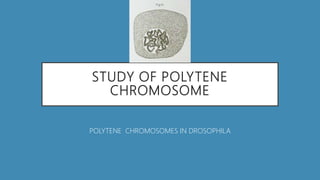
Lab Study of Polytene Chromosomes.
- 1. STUDY OF POLYTENE CHROMOSOME POLYTENE CHROMOSOMES IN DROSOPHILA
- 2. INTRODUCTION • Polytene chromosomes are over-sized chromosomes which have developed from standard chromosomes and are commonly found in the salivary glands of DROSOPHILA MELANOGASTER Specialized cells undergo repeated rounds of DNA REPLICATION without CELL DIVISION, to increase CELL volume, forming a giant polytene chromosome. Polytene chromosomes form when multiple rounds of replication produce many sister chromatids that remain synapsed together.
- 3. HISTORY • Polytene chromosomes were originally observed in the larval SALIVARY GLANDS of CHIROMOMUS midges by Balbiani in 1881, but the hereditary nature of these structures was not confirmed until they were studied in DROSOPHILA MELANGOSTER in the early 1930s by EMIL HEITZ and HANS BAUER. They are known to occur in secretory tissues of other DIPTERAN insects such as the MALPHIGIAN TUBULES of Sciara and also in protists, plants, mammals, or in cells from other INSECTS. Some of the largest polytene chromosomes described thus far occur in larval salivary gland cells of the Chironomid genus Axarus.
- 4. FUNCTIONS • In addition to increasing the volume of the cells' nuclei and causing cell expansion, polytene cells may also have a metabolic advantage as multiple copies of genes permits a high level of gene expression. In Drosophila melanogaster, for example, the chromosomes of the larval salivary glands undergo many rounds of endoreduplication, to produce large amounts of glue before pupation. Another example, within the organism itself is the tandem duplication of various polytene bands located near the centromere of the X chromosome which results in the Bar phenotype of kidney-shaped eyes.
- 5. STRUCTURE • Polytene chromosomes have characteristic light and dark banding patterns that can be used to identify chromosomal rearrangements and deletions. Dark banding frequently corresponds to inactive chromatin, whereas light banding is usually found at areas with higher transcriptional activity. The banding patterns of the polytene chromosomes of Drosophila melanogaster were sketched in 1935 by Calvin B. Bridges.
- 8. STRUCTURE CONTINUED.. • The banding patterns of the chromosomes are especially helpful in research, as they provide an excellent visualization of transcriptionally active chromatin and general chromatin structure. For example, the polytene chromosomes in Drosophila have been used to support the theory of genomic equivalence, which states that all of the cells in the body maintain the same genome. Polytene chromosomes are about 200 micrometer in length. The chromonema of these chromosomes divide but do not separate. Therefore, they remain together to become large in size.
- 9. PROCEDURE • The success of these experiments is largely determined by the developmental stage of the larvae. • If they are too small, their salivary glands will not be sufficiently developed to yield good chromosomes. • Choose the largest larvae that you can find that is still moving actively. • Do not choose the larvae that is noticebly darker than the rest. • Darkening of the cuticle is a sign that pupation is imminent.
- 10. PREPARING SALIVARY SQUASHES • Place a drop of 0.7% saline on a clean slide. • Transfer an appropriate larva to the slide and place it on the stage of a dissecting microscope. • Using the enhanced detail afforded by the microscope, firmly grasp the posterior end of the larva with forceps and use a dissecting needle to pierce through the head. • Using a continuous motion pull the needle away from the body. • The salivary glands are recognised by the foll. features: • They are paired and each is identical in shape and size. • They have a glistening, translucent appearance. • Each gland should have an opaque fat body associated with it.
- 11. • While continuing to observe under the microscope, separate the salivary glands from any extraneous material, such as the fat bodies or parts of the digestive tract. • Once cleaned, remove the used saline and debris from the slide. Add fresh saline and allow the glands to soak for ten minutes. • Carefully place 1-2 drops of acetocarmine or aceto-orcein stain on each of the regions. • Wait for a couple of minutes and proceed to the next step.
- 12. • Crushing glands to expose cells: Place a cover slip carefully in each of the regions of the slide where salivary glands were placed. • Crush each cover slip against the slide with the help of your thumb. • If the crushed region appears too thick, flatten it further by tapping the coverslip multiple times with the back of a dissecting needle • Allow the exposed cells to absorb the stain for 5-10 minutes.
- 13. IDENTIFYING THE POLYTENE CHROMOSOME UNDER A MICROSCOPE • Place the slide under the microscope . • Locate the squashed regions under 4x and 10x objective magnification to see where to focus. • Once those are determined change the objective to 40x to locate individual cells. • If certain fibrous projections appear, switch to 100x. • Light and dark bands are observed as shown. • Hence the procedure comes to an end.
- 14. REFERENCES • https://en.wikipedia.org/wiki/Polytene_chromosome • https://www.ncbi.nlm.nih.gov/pmc/articles/PMC2821744/ • http://msg.ucsf.edu/sedat/polytene_chrom.html
